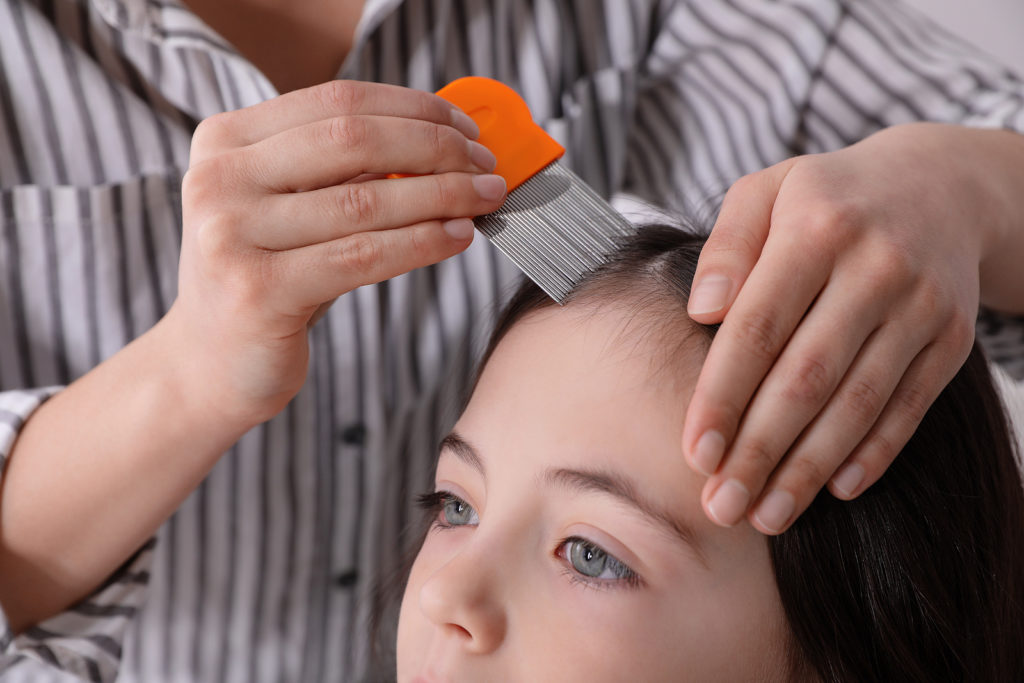
It’s the note in their child’s backpack that no parent wants to find—an infestation of head lice in their child’s class, day care center or summer camp.
Parents can take comfort from knowing that head lice infestations are quite common among children ages 3-11, are easy to treat and do not carry disease.
The head louse is a parasitic insect about the size of a sesame seed that attach to the head, eyebrows, and eyelashes of humans. Head lice live close to the scalp where they feed on human blood and lay their eggs, called nits.
Head lice spread through head-to-head contact with someone who is already infested, occurring during children’s play at home or school, on the playground, or at camp. Head lice infestation is not caused by a lack of personal hygiene or cleanliness in the home or school.
Head lice can crawl from the clothing or belongings recently used by an infested person to a new host. Avoid sharing hats, scarves, coats, sports uniforms, hair ribbons, barrettes, combs, brushes, towels, or stuffed animals if you suspect infestation. Head lice may also spread if a child lies on a bed, couch, pillow or carpet that an infested person has recently contacted.
Head lice do not go away on their own. If you suspect your child has an infestation, first call your doctor to confirm the diagnosis. Notify your child’s day care or school. Inspect other family members for signs of head lice and treat everyone at the same time.
DETECTING HEAD LICE
Though small, head lice and nits are visible to the naked eye. Adult head lice can be white, brown, or dark gray, and hold tightly to hair with hook-like claws. The nits are round or oval specks that attach firmly to the hair shaft, making them difficult to remove.
To determine if your child has head lice, use a fine-tooth comb (drug stores sell nit combs for this purpose) and comb through your child’s wet hair from the scalp to the end of the hair. Use a bright light and carefully examine the scalp, behind the ears and in the hair at the back of the head.
Other indications your child may have head lice include:
- A tickling feeling as if something is moving in the hair.
- Itching, sometimes caused by an allergic reaction to the saliva of the insects.
- Sores on the head caused by scratching, which can lead them to become infected.
Treatment
See your doctor before treating head lice at home. Itching and white flecks in the hair might be caused by dandruff or psoriasis. Your doctor may recommend one of several available head lice medications that you can get without a prescription. Be sure to carefully follow the label instructions when administering these medications. A second treatment may be needed a week to 10 days later. If you can still see crawling lice on your child after a full course of treatment, contact your health care provider.
As soon as your doctor confirms an active case of head lice, the following actions will help to minimize the chances of reinfestation:
- Soak combs and brushes used by the infested person in very hot water (130 degrees) for 5–10 minutes.
- Machine wash and dry clothing, bed linens, and other items that the infested person has worn or used. Set your washer to the hottest water setting and the dryer to high heat. Clothing and items that are not washable can be dry-cleaned or sealed in a plastic bag for two weeks.
- Avoid using fumigant sprays or fogs, which can be toxic if inhaled or absorbed through the skin.
Prevention
Preventing and controlling the spread of head lice requires careful attention to your child’s environment, especially if cases of head lice have been reported at school or other places your child frequents.
- Teach your child to avoid head-to-head contact during play and other activities and to avoid sharing clothing and other personal items with others, such as hats, scarves, combs, hairbrushes or barrettes.
- Caution your child against lying on beds, couches, pillows, carpets, or stuffed animals in any environment where an infestation is present or recently detected.
- Thoroughly vacuum the floor and furniture where a known infested person might have placed their head.
- If an infestation has been reported at your child’s school or daycare, do a nightly check of your child’s scalp. Doing this regularly will not only help you spot an infestation early but will also decrease the chances of spreading it others.
WORK CITED
“Head Lice.” Centers for Disease Control and Prevention. Page last reviewed: September 12, 2019. https://www.cdc.gov/parasites/lice/head/index.html
“Head Lice Overview.” Mayo Clinic. https://www.mayoclinic.org/diseases-conditions/head-lice/symptoms-causes/syc-20356180
Gehris, Robin P., M.D. “Children and Lice – What to Know.” UPMC Children’s Hospital of Pittsburgh. https://www.childrenspeds.com/health-resources/sick-care/head-lice
Treating and Preventing a Head Lice Infestation. WebMD. https://www.webmd.com/children/ss/slideshow-lice-overview
